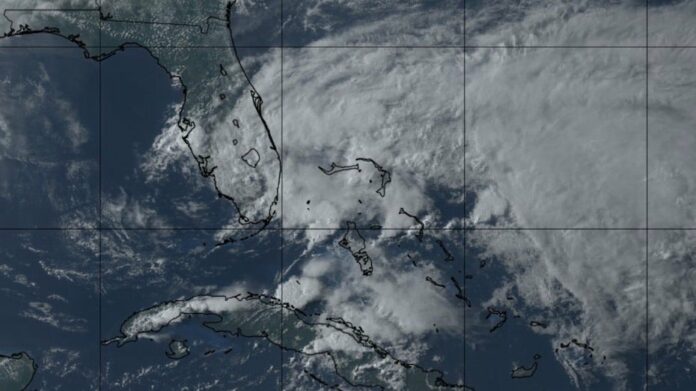Above: GeoColor image of 90L at 2142Z (5:42 pm EDT) Friday, May 15, 2020. (tropicaltidbits.com)
A disorganized complex of showers and thunderstorms (convection), Invest 90L, is expected to sharpen and become a tropical or subtropical storm by late Saturday in or near the Northwest Bahamas. We may be watching this one for a few days, as the storm is expected to intensify while moving northeast, perhaps toying with the coast of North Carolina early next week.
In a special tropical weather outlook issued at 8 pm EDT Friday, the NOAA/NWS National Hurricane Center placed 80% odds on tropical or subtropical development between now and Monday, most likely over the weekend. A hurricane hunter flight is scheduled to investigate 90L on Saturday morning if needed.
A southwest-to-northeast elongated surface circulation associated with 90L stretched on Friday evening from the Florida Straits toward the Northwest Bahamas. Most of the convection was being pushed by strong westerly upper winds into the moisture-pooling area on the southeast side of 90L, with only light showers across South Florida. This system appeared to be in no immediate hurry to develop, with little change in organization during the day Friday.
The pace should pick up over the weekend, as wind shear over 90L will drop from the 20-30 knot range into the 10-20 knot range as the system drifts northeast over the Gulf Stream between South Florida and The Bahamas. The reduced shear should help allow a center of circulation to organize and strengthen. Given that it’s still early in the warm season, sea surface temperatures beneath 90L on Saturday will be only about 26°C (79°F), which is the standard minimum benchmark for tropical development. By Sunday, wind shear may be even lower, allowing the system to intensify further, but 90L will also to traverse sub-26°C waters, which will skew the odds toward a subtropical vs. tropical mode.
The system should be more solidly in the subtropical vein by Monday, when the system may pass within 200 miles of the North Carolina coast—perhaps near enough for breezy conditions and a few squally showers on the Outer Banks. Arthur should progress away from the coast from that point onward, with its wind field likely expanding over time.
The bigger question mark hangs over the period from Monday to Wednesday, as a large upper low cut off from the jet stream is expected to settle into the mid-Atlantic or Southeast. There is a slight chance that if 90L doesn’t get enough of a push out to sea from upper-level westerlies, it could get caught up in the circulation around the upper low and angle northwest toward New England, if only briefly. In any event, a dreary week of onshore flow and cool, damp conditions appears to be in store for the Eastern Seaboard from Virginia northward.
A nomenclature note: If a named storm manages to intensify to hurricane strength, NHC policy is to declare it a hurricane whether it was previously classified as subtropical or tropical. Such an event is unlikely but can’t be ruled out with 90L at some point early next week.
With another early bird at hand, is it time to rethink Atlantic hurricane season?
If 90L develops as expected this weekend, it will be named Arthur. This would be the sixth time in six years that the Atlantic has produced its first named storm prior to the official start of hurricane season on June 1. While this suggests a trend may be afoot, and that perhaps the seasonal start date ought to be moved up, the reality is more complicated. For an excellent roundup of thinking along these lines, see the essay published Friday in Forbes by Weather Geeks podcast host Marshall Shepherd: “Why The June 1st Start Date Of Hurricane Season Is Just Fine.”
A serious threat for next week in the Bay of Bengal
A disturbance in the southern Bay of Bengal continued to gradually organize on Friday, and models continued to paint a disturbing picture of its potential for havoc. The European and GFS have consistently called for this system to become a powerful hurricane-strength cyclone by early next week, moving toward the north end of the Bay of Bengal, one of the planet’s most cyclone-vulnerable areas. For more on this system, see the post from earlier Friday by Dr. Jeff Masters.






